[NEW RELEASED] Free Download 70-243 Exam VCE Test Software With All Latest 70-243 Exam Questions from Braindump2go (1-10)
The 70-243 Exam Practice Questions and Answers are ideal for the aspring candiates to grab exceptional grades in Microsoft 70-243 Exam! The 70-243 Questions and Answers are developed using the latest updated course content and all the answers are verified to ensure phenoment preparation for the actual 70-243 Exam! Vendor: Microsoft
Exam Code: 70-243
Exam Name: Administering and Deploying System Center 2012 Configuration Manager 
QUESTION 1
You recently migrated from System Center 2012 Configuration Managerto System Center 2012 Configuration Manager.
Your network contains a client computer that runs the 64-bit version of Windows 7 and the 32-brt version of Widows 7.
Some client computers have the Microsoft Application Virtualization (App-V) client installed.
You have an Application named App1.
You have a 64-bit version of App1, a 32-bit version of App1, and a virtual version of App1.
You need to deploy the Application to all of the client computers.
The solution must minimize the amount of administrative effort.
What should you do? A. Create a new Application that has three different deployment types and create a target collection for
each of the deployment types.
B. Create a new Application that has three different deployment types and configure global conditions for
each of the deployment types.
C. Create a new package for each version of App1.
D. Create a new Application for each version of App1. Answer: B
Explanation:
Applications contain multiple deployment types that contain the files and commands necessary to install the software. For example, deployment types for a local installation, a virtual application package or a version of the application for mobile devices. MSI 64, 32 deployment types 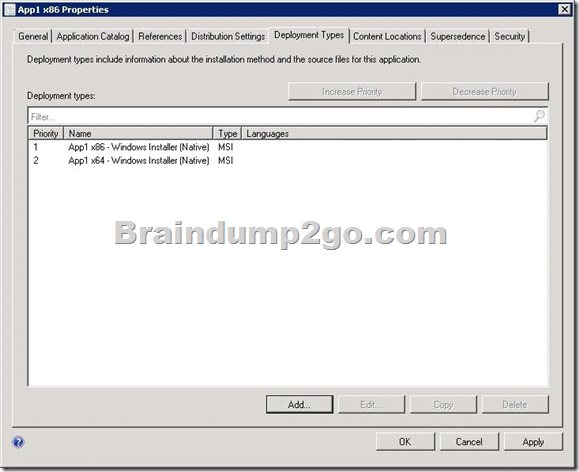
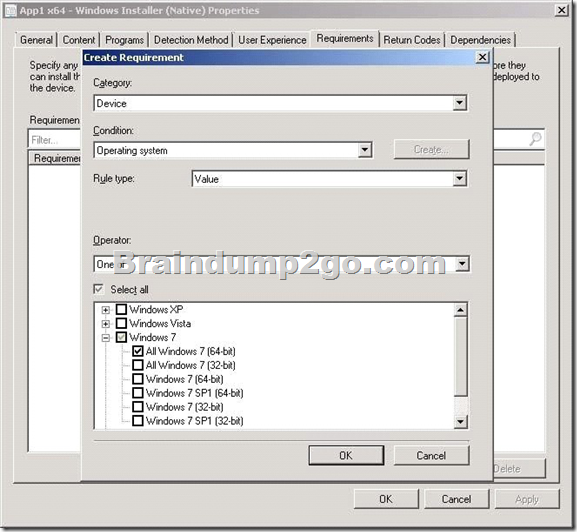
Deploy multiple type to multiple collection ( x64, x32, VirtualUserCollection)
You don't choose to deploy a specific deployment type. Instead, you deploy the application itself. It's pretty simple in this case, with only one deployment type, as it's fairly obvious which one will be installed. But if you had multiple deployment types, you would need to specify rules to determine which one is used. QUESTION 2
Your company uses System Center 2012 Configuration Manager with Microsoft Forefront Endpoint Protection integration.
You deploy Forefront Endpoint Protection to all client computers.
The company uses a management Application named App1.
You discover that Forefront Endpoint Protection blocks App1.
You need to ensure that App1 can run.
How should you configure the Default Client Malware Policy?
(Each correct answer presents a complete solution. Choose two.) A. Create a software restriction policy.
B. Add a process exclusion.
C. Add a file location exclusion.
D. Modify the schedule scan settings.
E. Click the Use behavior monitoring check box. Answer: BC
Explanation:
http://technet.microsoft.com/en-us/library/hh508785.aspx
How to Create and Deploy Antimalware Policies for Endpoint Protection in Configuration Manager 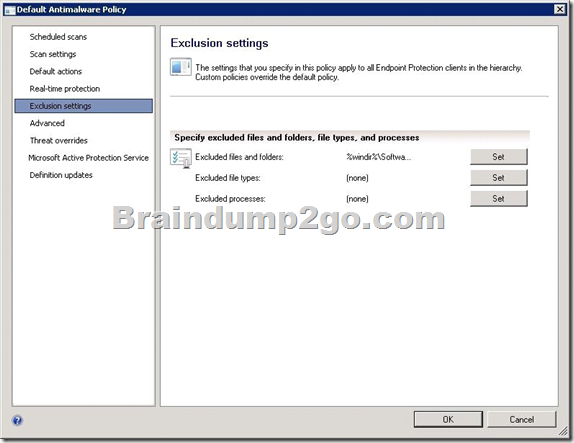
QUESTION 3
You have an Application named App1.
You need to ensure that users in the finance department can install App1 by using the Application Catalog.
What should you do?
A. Create a required user deployment and target the deployment to all of the finance department users.
B. Create a required user deployment and target the deployment to all of the client computers in the
finance department.
C. Create an available user deployment and target the deployment to all of the finance department users.
D. Create an available user deployment and target the deployment to all of the client computers in the
finance department. Answer: C
Explanation:
By selecting "Available" it will be selectable for the users in the Application Catalog.
The "Required" option would force the installation to all users in the finance department. QUESTION 4
Your network contains a System Center 2012 Configuration Manager environment.
You deploy a Microsoft Office 2007 package to all client computers by using Configuration Manager.
Your company purchases Office 2010.
You need to ensure that all users can install Office 2010 from the Application Catalog.
What should you do? A. Deploy a new package for Office 2010.
B. Deploy Office 2010 by using a Group Policy Object (GPO).
C. Update the Office 2007 source file and redeploy the package.
D. Deploy a new Application for Office 2010. Answer: D
Explanation:
http://technet.microsoft.com/en-us/library/gg699369.aspx
Packages and Programs in Configuration Manager
Microsoft System Center 2012 Configuration Manager continues to support packages and
programs that were used in Configuration Manager 2007.
You can use Microsoft System Center Configuration Manager Package Conversion
Manager to convert packages and programs into Configuration Manager applications.
Further information:
http://technet.microsoft.com/en-us/library/gg682125.aspx
Introduction to Application Management in Configuration Manager QUESTION 5
You deploy Windows 7 by using Operating System Deployment (OSD).
The development task sequence contains steps to install software updates and Applications.
The amount of time required to deploy the Windows 7 image has increased significantly during the last six months.
You need to recommend a solution to reduce the amount of time it takes to deploy the image. What should you recommend? A. Synchronize software updates before deploying the image.
B. Use offline servicing for the image.
C. Create a new automatic deployment rule.
D. Add an additional Install Software Updates step to the deployment task sequence. Answer: B
Explanation:
By updating an image in the Software Library instead of performing a new build and capture of the operating system image you will gain a few distinct advantages.
You will be able to reduce the risk of vulnerabilities during operating system deployments and reduce the overall operating system deployment to the end user.
You will also reduce the administrative effort to maintain your operating system images.
The feature is applicable for Component Based Servicing (CBS) updates and for the following operating systems:
Microsoft Windows Vista SP2 and later
Microsoft Windows Server 2008 SP2 and later
Microsoft Windows 7 RTM
Microsoft Windows 2008 R2
* At the launch of ConfigMgr 2012 Beta 2 Microsoft Windows 7 SP1 and Windows Server 2008 R2 SP1 are not supported. They will be supported with Configuration Manager 2012 RTM. QUESTION 6
You have Windows 7 .mages that are rebuilt quarterly and sported to System Center 2012 Configuration Manager.
The Microsoft Deployment Toolkit (MDT) 2012 is integrated with Configuration Manager.
You need to reduce the network security risks when the images are deployed by using Operating System Deployment (OSD).
What should you do? (Choose all that Apply.) A. After the Apply Operating System Image task sequence step, add a step to install software
updates offline.
B. Before the Apply Operating System image task sequence step, add a step to install Deployment
Imaging Servicing and Management (DISM).
C. After the installation of the final Application, add an Install Software Updates task sequence step.
D. After the Apply Operating System Image task sequence step, add a Run Command line step
that runs wuaudt.exe /detectnow
E. Before the Apply Operating System image task sequence step, add a step to install the Windows
Automated Installation Kit (Windows AIK). Answer: AC
Explanation:
With Config Manager 2012, software updatescan be applied offline.
A. We apply the OS image, then install software updates (windows updates) offline before
starting the OS.
C. Install software applications, then install updates (application updates) to the
applications.
INSTALLING SOFTWARE UPDATES DURING SCCM OSD
Preparation:
To be able to deploy software updates during the deployment of Windows 7 using SCCM, the Microsoft Deployment Toolkit (MDT) 2010 Update 1 must be integrated with SCCM. 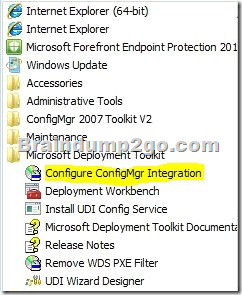
This integration will add MDT task sequences to SCCM. Adding the Install Updates Offline step to Task Sequence:
To install software updates while Windows 7 is being deployed using SCCM, the Install Updates Offline task should be used in the task sequence used to deploy the OS. This task will install all the software updates included in a specific SCCM deployment package after the image has been applied to the disk. This task should be placed in the PostInstall group just before the Configure task. To insert the task, select the task just above the Configure task, and then click on Add in the pull-down menu bar on the top, hi-lite MDT and click on Install Updates Offline 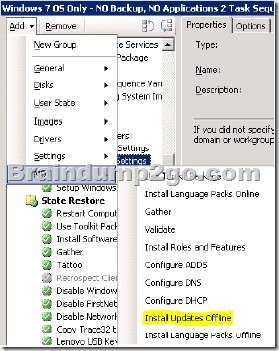
Configure the task by browsing to select the Updates package that contains the security updates that you want to install. 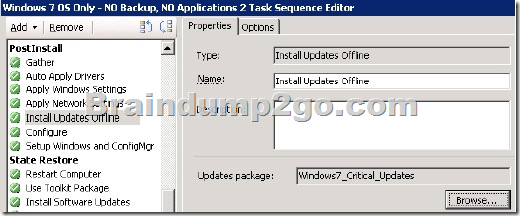
You can add as many Install Updates Offline tasks as needed as only one package can be included per task. 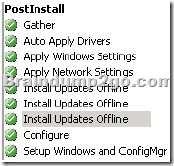
QUESTION 7
You install a secondary site at a branch office.
You discover that communication is not occurring between the secondary site and its parent site. You need to ensure two-way communication between the secondary site and its parent site.
What should you do?
A. On the parent site, create a standard sender address to the secondary site.
B. On the parent site, create an asynchronous RAS sender to the secondary site.
C. On the secondary site, create an asynchronous RAS sender to the parent site.
D. On the secondary site, publish the Configuration Manager site information to Active Directory. Answer: A
QUESTION 8
You have a secondary site at a branch office.
The branch office is connected to the main office by a 512-Kbps (kilobits per second) WAN link.
You need to eliminate all package distribution traffic on the WAN from the primary site between 3:00 P.M. and 5:00 P.M.
Which two tasks should you do on the sender address?(Each correct answer presents part of the solution. Choose two.) A. Configure rate limits for the primary site.
B. Configure pulse mode for the primary site.
C. Configure pulse mode for the secondary site.
D. Configure a schedule for the primary site. Answer: AD
QUESTION 9
Currently, you collect software inventory data on a monthly basis.
You need to ensure that all software inventory reports include data about software that was installed as recently as the past seven days.
What should you do? A. Configure the software update point synchronization schedule to run every seven days.
B. Create a custom Configuration Manager Web report to display all software inventory changes that
occurred within the past seven days.
C. Configure the Software Updates client agent to run every seven days.
D. Configure the Software Inventory client agent to run every seven days. Answer: D
QUESTION 10
Local client computers receive software updates from Configuration Manager. You need to ensure that remote client computers that connect to the virtual private network (VPN) are able to receive software updates. What should you do? A. Create a new site system, and configure it with the Software Update Point role.
B. Create a new site system, and configure it with the SMS Provider role.
C. Add the IP subnets that the VPN uses to the network discovery.
D. Create a new site boundary, and add the IP subnets that the VPN uses to the site boundary.
Braindump2go New Updated 70-243 Exa Dumps are Complete Microsoft 70-243 Course Coverage! 100% Real Questions and Correct Answers Guaranteed! Updated 70-243 Preparation Material with Questions and Answers PDF Instant Download: 
http://www.braindump2go.com/70-243.html
|








